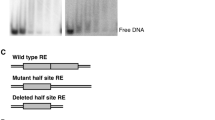Abstract
p53 is activated in response to DNA damage and functions in the maintenance of genetic integrity. Loss of p53 function because of mutation of the p53 gene is associated with over half all human cancers. Certain human p53 mutants are conformationally flexible in vitro and are temperature sensitive, with partial or complete recovery of wild-type (wt) properties at 32 degrees C. We have now tested the functional capacities of selected p53 mutants in vivo, by transfection into established human cell lines. Unexpectedly, we found that wt p53 can be temperature sensitive for transactivation of a co-transfected target gene in vivo. Flexible mutants retained varying degrees of functional capacity in transfected cells, and the recipient cell line appeared to be a significant determinant of both wt and mutant p53 function; importantly, two p53 null cell lines commonly used to study p53 function (Saos-2 and Hep3B) differed markedly in this latter respect. We also show that the p53 mutant V272M, which exhibits sequence-specific DNA binding in vitro, is nonetheless defective for transactivation and is unable to induce apoptosis in vivo. The valine 272 residue may thus be crucial for properties (other than sequence-specific DNA binding) that are important for p53 function(s) in vivo.
Similar content being viewed by others
Author information
Authors and Affiliations
Rights and permissions
About this article
Cite this article
Ponchel, F., Milner, J. Temperature sensitivity of human wild-type and mutant p53 proteins expressed in vivo. Br J Cancer 77, 1555–1561 (1998). https://doi.org/10.1038/bjc.1998.256
Issue Date:
DOI: https://doi.org/10.1038/bjc.1998.256
- Springer Nature Limited




